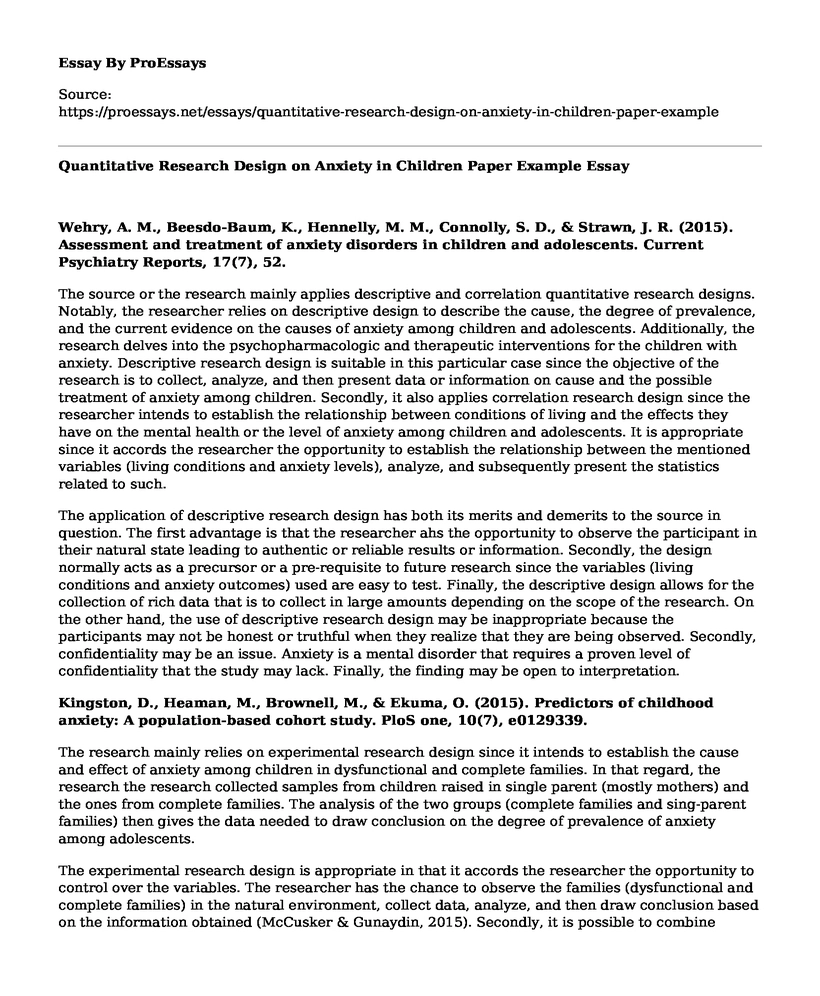Wehry, A. M., Beesdo-Baum, K., Hennelly, M. M., Connolly, S. D., & Strawn, J. R. (2015). Assessment and treatment of anxiety disorders in children and adolescents. Current Psychiatry Reports, 17(7), 52.
The source or the research mainly applies descriptive and correlation quantitative research designs. Notably, the researcher relies on descriptive design to describe the cause, the degree of prevalence, and the current evidence on the causes of anxiety among children and adolescents. Additionally, the research delves into the psychopharmacologic and therapeutic interventions for the children with anxiety. Descriptive research design is suitable in this particular case since the objective of the research is to collect, analyze, and then present data or information on cause and the possible treatment of anxiety among children. Secondly, it also applies correlation research design since the researcher intends to establish the relationship between conditions of living and the effects they have on the mental health or the level of anxiety among children and adolescents. It is appropriate since it accords the researcher the opportunity to establish the relationship between the mentioned variables (living conditions and anxiety levels), analyze, and subsequently present the statistics related to such.
The application of descriptive research design has both its merits and demerits to the source in question. The first advantage is that the researcher ahs the opportunity to observe the participant in their natural state leading to authentic or reliable results or information. Secondly, the design normally acts as a precursor or a pre-requisite to future research since the variables (living conditions and anxiety outcomes) used are easy to test. Finally, the descriptive design allows for the collection of rich data that is to collect in large amounts depending on the scope of the research. On the other hand, the use of descriptive research design may be inappropriate because the participants may not be honest or truthful when they realize that they are being observed. Secondly, confidentiality may be an issue. Anxiety is a mental disorder that requires a proven level of confidentiality that the study may lack. Finally, the finding may be open to interpretation.
Kingston, D., Heaman, M., Brownell, M., & Ekuma, O. (2015). Predictors of childhood anxiety: A population-based cohort study. PloS one, 10(7), e0129339.
The research mainly relies on experimental research design since it intends to establish the cause and effect of anxiety among children in dysfunctional and complete families. In that regard, the research the research collected samples from children raised in single parent (mostly mothers) and the ones from complete families. The analysis of the two groups (complete families and sing-parent families) then gives the data needed to draw conclusion on the degree of prevalence of anxiety among adolescents.
The experimental research design is appropriate in that it accords the researcher the opportunity to control over the variables. The researcher has the chance to observe the families (dysfunctional and complete families) in the natural environment, collect data, analyze, and then draw conclusion based on the information obtained (McCusker & Gunaydin, 2015). Secondly, it is possible to combine experimental research design with other methods such as descriptive design for comprehensive results. Finally, it experimental research provides for better transferability of data than the anecdotal research. On the other hand, the sample used may not be representative because it is merely a small fraction of the population, meaning that the results may not be conclusive. Moreover, the personal bias of the researcher may have personal bias that may form part of the result leading to inaccuracies.
Ramifications of Choosing an Inappropriate Design for a Research Study
Research design provides the necessary platform for the application of the right processes and methods for gathering, analyzing, and presenting the information required (Polit, D. F., & Beck, 2012). It means that a research design is the bridge that ensures that achievement of the research or study objectives. Lack of or inappropriate design will lead to poor anticipation of client's requirement about the results and the analytical work on the data gathered. Therefore, lack of an explicit design means that the researcher will merely have unclear, foggy ideas on what to do. Secondly, lack of or the application of an inappropriate design may lead to the collection of irrelevant data that will certainly be inefficient. Inappropriate design leads to a path that is inconsistent with the recommendations and conclusions of the study. In retrospect, a research design provides the necessary roadmap for the study, and lack of it will scatter the entire research process from collection of data to the final stage that is the presentation.
References
Kingston, D., Heaman, M., Brownell, M., & Ekuma, O. (2015). Predictors of childhood anxiety: A population-based cohort study. PloS one, 10 (7), e0129339. Retrieved from https://journals.plos.org/plosone/article?id=10.1371/journal.pone.0129339#abstract0
McCusker, K., & Gunaydin, S. (2015). Research using qualitative, quantitative or mixed methods and choice based on the research. Perfusion, 30(7), 537-542.
Polit, D. F., & Beck, C. T. (2012). Nursing research: Generating and assessing evidence for nursing practice (Laureate Education, Inc., custom Ed.). Philadelphia, PA: Lippincott Williams & Wilkins
Wehry, A. M., Beesdo-Baum, K., Hennelly, M. M., Connolly, S. D., & Strawn, J. R. (2015). Assessment and treatment of anxiety disorders in children and adolescents. Current psychiatry reports, 17(7), 52. Retrieved from https://www.ncbi.nlm.nih.gov/pmc/articles/PMC4480225/
Cite this page
Quantitative Research Design on Anxiety in Children Paper Example. (2022, Nov 07). Retrieved from https://proessays.net/essays/quantitative-research-design-on-anxiety-in-children-paper-example
If you are the original author of this essay and no longer wish to have it published on the ProEssays website, please click below to request its removal:
- Role of Teacher in Determining the Academic Performance of Students - Reflective Essay
- Criticisms of the Educational Philosophies Essay
- My Core Beliefs About Work
- Autobiographical Sketch
- Essay Example on Family Dynamics: Love, Loyalty, Disappointments & Beyond
- Essay on Modern Epoch: Combining Mindfulness, Cognitive, & Behavioral Therapies
- Essay Example on My Improvement Despite Attention Deficit Problem Caused by Excessive Electronics







